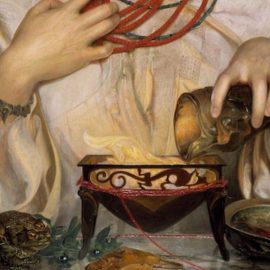

This article is an excerpt from the Shortform book guide to "The Bhagavad Gita" by Eknath Easwaran. Shortform has the world's best summaries and analyses of books you should be reading.
Like this article? Sign up for a free trial here .
What are The Bhagavad Gita lessons? What does the book teach about Hinduism and spirituality?
The main The Bhagavad Gita lessons are about finding God and spirituality through your purpose. These lessons are taught through main character Arjuna, who talks with the god Krishna.
Read more about The Bhagavad Gita lessons.
The Bhagavad Gita Lessons
One lesson that’s central to all of Krishna’s teachings is the difference between reality and illusion. Anything temporary shouldn’t be considered real. This includes physical matter, sensations, thoughts and feelings, and even good and bad fortune. They’re all transient, belonging to the category that Krishna calls “sense-objects” or prakriti—that is, things that either are physical objects or are experienced physically.
Very few things are actually real and worthy of attention. However, your true self, the Purusha or soul that inhabits the body, is real. Though you will die and be reborn countless times, the Purusha itself never changes. It puts on bodies and casts them off as easily as you change your clothes, and with no greater impact on itself.
The other reality is the divine. Krishna himself, who is an incarnation of the god Vishnu, is real. In turn, Vishnu himself is only one aspect of Brahman, the ultimate power and truth in the universe. Everything that exists—from the smallest speck of dirt, to entire worlds, to Purusha—comes from Brahman and is part of Brahman.
Understanding the difference between what’s real and what’s not is key for Arjuna to fight in the upcoming battle. He doesn’t want to hurt his kin—but Krishna makes the point that he can’t hurt them, only their temporary physical bodies. Damaging Purusha, their true selves, is impossible, and therefore there’s no reason for Arjuna to hesitate. This leads to other The Bhagavad Gita lessons.
Selflessly Fulfill Dharma
The other reason why Arjuna must fight is that it’s his dharma—both his duty and his destiny. Dharma is what someone’s on Earth to do.
Krishna mentions that he takes a mortal form when he’s needed on Earth in order to set dharma back on its proper course; in other words, when people turn away from their destinies. These lessons for Arjuna are part of making sure that people fulfill dharma as they should.
Krishna goes on to say that Arjuna should fulfill his dharma through selfless action, which is a frequent theme in The Bhagavad Gita. “Selfless” isn’t used in the more common sense of “charitable,” but meaning literally without thought or concern for oneself. Krishna says repeatedly that Arjuna should work to fulfill his dharma, while devoting every action that he takes to Krishna himself instead of focusing on selfish concerns.
Arjuna shouldn’t be concerned with personal gain or rewards, or even with the outcomes of his actions. The key to selfless action is to do what’s right and leave the results in God’s hands. This renunciation of outcomes and consequences is called tyaga, which is one path to enlightenment.
Escaping From Karma
This focus on selfless action is important because it’s the best way for Arjuna to break free of karma. You may have heard the colloquial meaning of karma: Being rewarded for good deeds and punished for bad ones. However, this is a corrupted definition of the concept.
Karma is the cosmic force that binds people to samsara, the cycle of death and rebirth. What a person does in life affects that person’s afterlife, and what kind of new life he or she is placed into next. Gaining and balancing karma, positive or negative, is a process that takes place over many lives and afterlives.
Usually, every action that a person takes, good or bad, is added to that person’s karma. However, by acting selflessly as Krishna describes, that person can remain detached from their actions and unconnected to the outcomes of them. Therefore, selfless actions don’t incur any karma.
Escaping karma and breaking free of samsara is the ultimate goal of Hinduism. Someone who has achieved this goal no longer has any karma, and therefore isn’t reincarnated anymore. Krishna repeatedly discusses this goal. He explains how those who achieve it are reunited with him in his true home, a place of pure light that exists within Brahman, beyond the universe as we know it.
The Three Gunas
The three gunus are another of The Bhagavad Gita lessons. Much of Krishna’s advice to Arjuna relates to the three gunas. Guna can be roughly translated as “attribute” or “property.” The three gunas are sattva, rajas, and tamas.
Sattva is the guna of goodness and wisdom, the only one of the three that’s desirable. Rajas is the guna of passion and anger; it often drives actions, but it traps the one doing them deeper in karma. Tamas is the guna of darkness, destruction, and depression.
Every action that people take is fueled by one of the three gunas. However, the gunas are part of prakriti—physical matter—and they trick people into egotism and obsession with the results of those actions.
Though every action comes from one of the three gunas, someone who understands the gunas’ true nature and isn’t distracted by them can perform these actions selflessly—concerned only for their dharma and the world around them, rather than seeking any material rewards for their work. Krishna advises Arjuna not to be ruled by his gunas; they’re obstacles in the way of enlightenment.
Bear this in mind as you read the following subsections. The gunas are intrinsically involved in everything you do and think, but it’s possible not to be controlled by them. By rising above your personal interests, renouncing the desire to feel sattva or to avoid tamas, it’s possible to experience the gunas without being truly affected by them.
Knowledge in Terms of the Gunas
Aside from action, one can also describe knowledge according to the three gunas.
Sattvic knowledge is the understanding that there’s a single, divine entity living in all things, and therefore all things are connected and unified. Sattvic understanding knows right from wrong, what will bring security and peace, and what will ultimately lead to freedom and union with God.
Rajasic knowledge is selfish; it doesn’t see the unity in everything, but it considers different things and creatures as separate entities. Because it lacks this crucial understanding, rajasic intellect can’t tell right from wrong. It pursues wealth, pleasure, and good reputation, often at the expense of others.
Tamasic knowledge is deluded—like a child, it sees one small part of the world and thinks that’s all there is, with no concept that there could be something beyond its own experiences. It’s even more confused than rajasic knowledge, and it mixes up right and wrong at every turn. It leads to fear, grief, sadness, and a refusal to learn from mistakes.
Happiness in Terms of the Gunas
The gunas can even be used to describe different types of happiness. Happiness that comes from selfless, sattvic knowledge and action is the hardest to achieve; it will feel bitter at first to work without any thought of personal gain. However, this is the only path to permanent—and therefore real—happiness.
Happiness that comes from rajas is immediate and pleasurable, but temporary. It’s the joy of getting something you’ve always wanted, or the thrill of eating a piece of spicy food. It fades quickly and reveals itself to be an illusion—remember, only that which is permanent and unchanging is real.
Tamasic happiness is a lie from beginning to end. It comes from idleness, sleep, and intoxication. This false happiness is to be avoided.
Many Paths to God
One important point Krishna makes is that there are many different ways to escape karma and be united with God in his home. Some people make material offerings, while others offer their selfless actions, as Krishna instructs Arjuna to do. Some seek God through meditation, restraining their senses and gaining mastery over their physical bodies through asceticism (self-deprivation), or offering up their bodies and experiences to the gods. All of these various practices are called yoga, which means “union”—specifically, union with God.
In vowing not to fight, Arjuna was—likely unintentionally—practicing one means of getting closer to the divine, called sannyasa, or renunciation of action. Those who practice sannyasa, typically ascetic monks, avoid taking any actions at all in order to minimize how much karma they accrue.
However, in shirking his duty to fight, Arjuna wasn’t practicing sannyasa correctly. Krishna explains that, for a warrior prince like Arjuna, sannyasa isn’t an appropriate path; it would be impossible for Arjuna to renounce all action, since his dharma drives him to fight and lead. Instead, Krishna again urges him to practice tyaga, dedicating his actions to God and renouncing the outcomes of those actions.
Selfless action is only one step on the spiritual path. Beyond selfless action is wisdom and knowledge. Studying the scriptures, knowing the difference between one’s physical form and one’s true self, and recognizing the spirit of Vishnu in everything that exists are all key to breaking free of samsara, escaping the cycle of rebirth, and being reunited with God. This an important one of The Bhagavad Gita lessons.
There Is No Failure in Spirituality
Throughout The Bhagavad Gita, Arjuna asks several questions about what happens if you worship other gods, or worship in different ways than are laid out in the sacred texts. Krishna answers that he’ll reward true faith of any kind. People who pray to other gods will be with them in the afterlife (until they’re reborn), while those who worship Vishnu but don’t follow the proper rituals will be reborn into an educated family to learn the correct forms and continue their spiritual journey.
Most importantly, Krishna says that there is no such thing as failure when pursuing spiritual work. Arjuna worries that if he begins to practice yoga but isn’t able to complete his spiritual journey in a single lifetime, that he’ll be stuck between the physical world and the spiritual one, truly belonging to neither.
However, Krishna reassures him that that’s impossible. If he seeks Vishnu in life but becomes distracted by physical attachments or turns away from his spiritual pursuits, he’ll enjoy his rewards in the afterlife until he’s born again to continue the work.
Krishna’s Nature
As a sacred text, much of The Bhagavad Gita is devoted to Krishna explaining his true nature. One of the most difficult, yet most important things to understand is all of the various forms that Krishna takes.
He says that his truest, highest self is Brahman, the ultimate truth and power in the universe. However, Brahman isn’t usually thought of as an entity. Rather, he’s thought of more like an abstract force that pervades the universe and guides everything in it.
Vishnu, who is one of many aspects of Brahman, is the supreme deity in the universe. Though commonly depicted as a blue-skinned, four-armed being, he is in everything that exists, and everything that exists is part of him.
Finally, Krishna is an avatar, or incarnation of Vishnu. Like Arjuna, Vishnu has been born into many different bodies throughout history; however, unlike Arjuna, Vishnu controls his own reincarnations and remembers his past lives. So Krishna, Vishnu, and Brahman are all separate entities, and yet all the same divine being.
The True Form of Brahman
Next in The Bhagavad Gita is a lesson about Brahman. After explaining his nature, Krishna—at Arjuna’s request—goes one step further and reveals his true self. This isn’t the form of Vishnu that usually appears in art and literature, but the absolute truth that is Brahman. However, Arjuna can’t see Brahman with his eyes—Krishna has to grant him spiritual sight so that he can receive the vision.
Arjuna then sees a being who shines like a thousand suns all rising together. Krishna’s true self has an infinite number of faces overseeing the entire universe. He carries countless weapons in countless hands as symbols of his limitless power. Within Krishna’s body, Arjuna sees the form of every object that has ever existed merged into one.
Arjuna sees the creator god Brahma sitting on a lotus flower; he sees all of the ancient sages, alongside mythical monsters. The entire universe makes up God’s body, which has infinite mouths, stomachs, arms, and eyes. The being wears a crown and gleams with heavenly jewels. The light that radiates from its body warms everything that exists.
Arjuna sees that the true form of Krishna is the ultimate mystery of the universe; the only truth he needs to know in order to break free of karma. Vishnu is the eternal guardian of dharma, or fate, who is reborn again and again to keep the world on its ordained path.
Arjuna sees all other gods, demigods, and demons, and the universe itself shaking in fear before God’s true self. Arjuna himself is terrified by one part of the vision: All of the warriors who have gathered at the field of Kurukshetra for the upcoming battle, the kings they fight for, the entire world, and countless other worlds are all streaming into Vishnu’s countless burning mouths to be destroyed and swallowed. God says that, among all his other forms and roles in the universe, he is the ultimate destroyer: time.
Arjuna is completely overwhelmed and falls to his knees. He shakes in terror and begs Vishnu to take on his more familiar, four-armed form. After a short while, Vishnu does so and soothes Arjuna’s fears.
Once Arjuna has gathered his thoughts again, Krishna—who has by this point resumed his human form—reiterates that Arjuna should take up his weapons and fight the Kauravas. Given what Arjuna just saw, Brahman as the ultimate destroyer, he should now understand that it will be God himself who kills Arjuna’s kin; Arjuna is simply one of the countless weapons in God’scountless hands. He also promises that, should Arjuna do his duty and fight the battle, that he is certain to win.
Final The Bhagavad Gita Lesson
The last of The Bhagavad Gita lessons is about dharma and teaching. As their conversation comes to a close, Krishna tells Arjuna two last, crucial things. The first is that he should work selflessly to fulfill his destiny; this is something Krishna’s told him repeatedly throughout the Gita, but this time he adds that it’s better to follow one’s own dharma, or duty—even imperfectly—than to try to pursue someone else’s. Arjuna’s dharma is to lead and to fight, not to retreat and meditate; if he tries to follow those more priestly pursuits, he’ll be doing the world and his own spiritual health a great disservice.
Finally, Krishna tells Arjuna to share what he’s learned, but only with those who are ready to receive the lessons. Anyone who’s lacking in devotion, discipline, or the desire to learn isn’t worthy of learning what Krishna has taught Arjuna throughout The Bhagavad Gita. However, teaching the divine mysteries to those who are ready to receive them is the greatest act of love and devotion that one can perform.
Krishna signals that their conversation is coming to an end. He asks whether Arjuna has been listening and whether his teachings have dispelled Arjuna’s doubts.
Arjuna replies that he’s freed from his uncertainties and misunderstandings. He vows to carry out Krishna’s will.

———End of Preview———
Like what you just read? Read the rest of the world's best book summary and analysis of Eknath Easwaran's "The Bhagavad Gita" at Shortform .
Here's what you'll find in our full The Bhagavad Gita summary :
- The key principles of the Hindu faith
- Why all spirituality is good and there is no single path to God
- The 3 reasons that can explain every action people take






